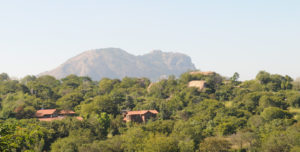
Varadenahalli is a small village forty kilometers to the west of Bangalore, not very far from Magadi, the nearest town. Our campus, a little more than 20 acres in extent, is located on a piece of land near the village. The land slopes down sharply to the north and the high rock at the southern end offers a dramatic view of the whole landscape around. There are terraces separated by clusters of big rocks.

The buildings are simple in structure and blend with the landscape. They have been designed for easy maintenance, and each houses about three teachers and fifteen students. Facilities include a spacious and well-stocked library, laboratories, a circular assembly hall, and art, craft, pottery and carpentry areas. Hostels double as classrooms, while the junior and middle school have dedicated learning spaces. The kitchen, as might be expected, is a major hub of teeming activity! We also have a modest guest house facility for overnight visitors.
A large part of the campus has been left as a ‘sanctuary’ for forest regeneration. We have protected the land from grazing and fires, and have ensured that rainwater recharges the land. These activities, along with regular tree planting over the past twenty years, have made our campus a small yet rich and diverse nature reserve. Over these years of the land regenerating through sustained care and efforts, we have seen a great diversity in flora and fauna. The campus continues to surprise us with new species of plants and animals previously unknown to the community. The land and its natural inhabitants have been one of our greatest educational resources. Over the years, teachers and students have engaged in various land-related activities as part of the curriculum. This includes growing vegetables, herbs and pulses, landscaping and studying biodiversity.

Being in a rural area with our own protected forest with patches of forest land nearby, we have had our share of occasional wild visitors – a bear in search of fruit, a leopard posing for a camera trap photo shoot, and a few wild boars. Apart from this, we have living amidst us a very healthy population of slender lorises, chameleons and many species of snakes. During the days of heavy rains we have seen large congregations of burrowing frogs that just appear out of nowhere! A glimpse of the campus can be seen on our Instagram page.
There is also a small area where we grow vegetables and fruits, and during the monsoon months we are able to produce a good proportion of the community’s vegetable requirement.
Over the years, we have augmented our alternative energy resources. We harvest most of our energy needs through solar panels. Though the primary fuel in the kitchen is gas, we also use firewood for baking and cooking with whatever dry and fallen wood is available to us from the campus. We are fairly conscious of our limited water supply (with the water table in the area dropping alarmingly), and water conservation has been extremely important. Kitchen grey water is recycled for use in the garden. We have built a few dry pit-toilets on campus, the use of which we encourage. This saves a considerable amount of water. The rain-water harvesting units in a few areas help us with water needs doing the monsoon months. We hope to grow in our rainwater harvesting systems in the years to come and are currently designing ways in which we can effectively do this in a larger scale for community use.
CFL made a conscious decision some 20 years ago to move to a rural campus, and the challenges and joys of life in this dry-deciduous area have enriched our lives immensely.